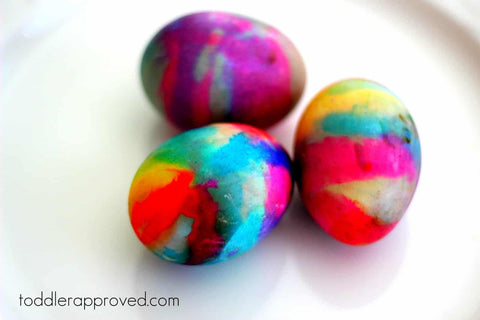5 Alternative Ways to Color Easter Eggs
Coloring eggs is such a fun Easter tradition for kids and adults alike; it’s a great way to spend time together as a family while also enjoying a creative outlet! Most people use the common method of dyeing eggs that involves the little color tablets you buy from the store dropped in vinegar, and there’s certainly nothing wrong with this age-old method, but why not change it up a little this year? How involved you get may need to differ depending on the age(s) of your child(ren), but there are a ton of different ways to dye eggs! We’ve rounded up some of the best in this list; from shaving cream to more natural dyes, there’s something for everyone.
1. Creamy Eggs
The cream in this project can be either whipped cream or shaving cream. Both are great options for kids of all ages; children love to play with cream in general, so why not incorporate it when you’re dyeing eggs? Fill a baking sheet with a layer of cream and then create a pattern on top with food coloring. Next, roll your eggs through the cream to transfer the colors, let dry, and remove any excess shaving cream. Your finished product will be beautifully swirled eggs! Both shaving cream and whipped cream will work for this activity, but if you plan to eat the eggs you might want to choose whipped cream to keep it non-toxic.

Image via
2. Volcano Eggs
What child (or adult!) doesn’t enjoy mixing baking soda and vinegar to see the subsequent explosion? Why not incorporate the popular volcano experiment into your Easter egg routine this year and give your kids a science lesson all at the same time. Create baking soda “paint” by combining baking soda with a little bit of water and some food coloring. Paint the eggs with this mixture, and then set off the “explosion” by pouring vinegar on them at the end. Let them air dry and you’ll be left with eggs of all different color combinations. If your kiddos are old enough, make sure to talk to them about the reaction between baking soda and vinegar, and how it can lead to these fizzy, fun eggs! Click here for more info and exact measurements.

Image via
3. Melted Crayon Eggs
Do your kids like to draw? If so, you need to give these melted crayon eggs a try! This project might be best for elementary-age kiddos or older because it requires the eggs to be pretty hot for it to work. All you have to do is hard boil your eggs, and then while they’re still hot, transfer them back to the egg carton. Start drawing on them with crayons right away; the heat will melt the wax, creating bright, bold colors! Just caution your kids not to bump the eggs with their hands due to the heat. When it’s time to flip them over to color on the other side, use tongs or oven mitts to protect your own hands. This is a fun way to get creative with your eggs without needing a lot of extra materials.

Image via
4. Plastic Bag Eggs
Looking for a mess-free way to color eggs with your smallest kids? Look no further than these plastic bag eggs! It doesn’t get much easier than this; simply squirt a couple of drops of acrylic paint into a ziplock bag (we recommend 2 or 3 coordinating colors to avoid making brown eggs) and then add a hard-boiled egg! Make sure the bag is closed up tight, and then let your little go to town squishing the egg in the bag with the paint. You’ll end up with beautifully-colored eggs and (hopefully) no paint on your child or anything else. And your little will love getting to experience the act of coloring eggs! This is a great way to involve them in an activity that their older brothers or sisters are doing, but in a way that’s safe and fun for their age.

Image via
5. Natural Eggs
It’s easy to get carried away on Easter and introduce candy and foods that we wouldn't normally allow in our kids’ diets, but just because you’re trying to stay natural doesn't mean your kids have to miss out on the fun of Easter. Did you know it’s possible to dye eggs without using any chemicals? Mother Nature has given us everything we need to make stunning eggs with all-natural ingredients. All you need is vinegar, water, and whatever fruits/vegetables/spices you plan to use to make the individual colors. For example, ground coffee is a great substitute for brown dye. Turmeric will yield a beautiful yellow color, blueberries (or blueberry juice) will make blue, grape juice will make purple, and beets, cranberries, red onions, and pomegranate juice are all excellent ways to make reds and pinks. This article and this one go more in-depth in the quantities you need of each ingredient, as well as some additional natural options you can use for coloring.

Image via
No matter how you choose to go about it, coloring eggs for Easter is a fun, hands-on activity that is sure to delight the whole family. As always, keep a close eye on your littles during these activities as they require parent supervision at all times. Looking for additional ways to make this Easter holiday fun for your kids? Be sure to check out our blog post here! Not to mention, we have a curated list of Easter gifts that are perfect for the little ones in your life.
Author: Alison Johnson
